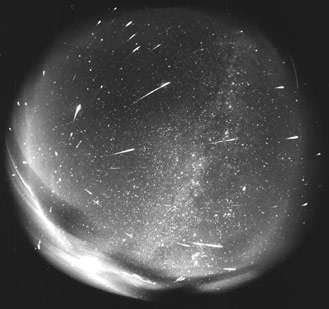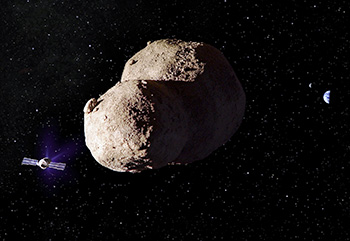A pair of astronomers monitoring an all-sky camera got a surprise (PDF) when they checked data from last February: a half dozen meteors all seemed to come from the same spot in the sky, indicating they all had a common origin. After doing some calculations, they found that they probably come from a parent comet with an orbit that’s at least 53 years long. Moreover, the orbit of this comet crosses that of the Earth, meaning we may have a close encounter with this object sometime in the future.
And because I can sense the oncoming panic on the web over this news, let me break it down for you. I’ll give you the science (which is cool), how we know this unseen comet may be potentially, um, interesting, then the reason you don’t need to run around in circles screaming (spoiler: it’s rude to others nearby, but also unnecessary).
But just to be up front: should you panic? Nope. We know there are objects out there that could hit us in the future sometime. This comet is in many ways just another one. As I’ll point out below, we pass through lots of meteor streams, so there are plenty of other comets that could hit us. I know, I know, that doesn’t sound reassuring, but think about it: how often is the Earth hit by a comet? Not very often, despite having a few on the list of Potentially Hazardous Objects. So having one more we know about out there isn’t great, but in reality doesn’t really make things any worse for us.
Meatier showers
That picture above is one of the meteors in question. You can see the streak as the tiny bit of rock (probably the size of a grain of sand) glowing as it rammed through the Earth’s atmosphere at about 35 km/sec (22 miles/sec, or nearly 80,000 mph). If you go out on any dark night, you’re bound to see the random meteor or five. But meteor showers are when we see lots of them in a short time, and they occur when the Earth passes through the dust debris left behind by a comet.
Most comets are dirty snowballs: dust, pebbles, and boulders held together by ice (water ice, but also frozen carbon dioxide and other things we normally think of as gases). This makes comets the litter bugs of the solar system, shedding material when the Sun warms them up and turns the ice into gas. The vapor blows off, and the looser material forms a ribbon or stream that stays more or less along the same orbit as the comet.
If the path of the comet intersects the orbit of the Earth, we plow through that material at the same time every year. Think of it this way: imagine a racetrack, and you are driving around it. Now also imagine a long line of gnats flying across the racetrack. You would drive through that line of bugs at the same point on the racetrack every time, right? OK, replace you with the Earth, the racetrack with the Earth’s orbit, and the bugs with debris shed off a comet. Since the Earth returns to the same point in its orbit every year, if there is cometary debris there, we’ll smack into it at roughly the same calendar day every year.
 This loose stuff from the comet burns up in our atmosphere, and we get a meteor shower. Due to perspective, we see them all radiating away from a single point in the sky, called the radiant. Going back to the car analogy, imagine driving through a tunnel with lights on the side. As you drive, the lights pass you on the left and right, but all seem to be coming from a spot up ahead. That’s the radiant. The image here [click to embiggen] shows the annual Leonids meteor shower as seen from the Modra Observatory in Slovakia, and you can see how they all point to the same spot in the sky.
This loose stuff from the comet burns up in our atmosphere, and we get a meteor shower. Due to perspective, we see them all radiating away from a single point in the sky, called the radiant. Going back to the car analogy, imagine driving through a tunnel with lights on the side. As you drive, the lights pass you on the left and right, but all seem to be coming from a spot up ahead. That’s the radiant. The image here [click to embiggen] shows the annual Leonids meteor shower as seen from the Modra Observatory in Slovakia, and you can see how they all point to the same spot in the sky.
In fact, meteor showers are named after the point in the sky from which they radiate. We get the Perseids in August (which stream away from the constellation Perseus), the Leonids in November (from Leo, like in that picture above), and the Geminids (Gemini, duh) in December. This new shower appears to come from a point near the star Eta Draconis in February, so these are now called the February Eta Draconids (to distinguish them from another shower, the Eta Draconids which appear in April [Note: these two meteor showers seem to have a lot of characteristics in common, which is interesting. I’m investigating that now.]
Knowing the path is not the same as walking the path
The meteors in question were caught by the Cameras for Allsky Meteor Surveillance, or CAMS. Five were seen for sure, and there may have been a dozen more. All seemed to come from that same spot in the sky, and all had similar brightnesses, speeds, and orbital characteristics (determined by backtracking the paths they made across the sky). Using these data, the astronomers determined that the parent comet – which has never been seen – is most likely one that takes a long time to circle the Sun, at least 53 years, and possibly more. The orbit of the comet is highly tilted to that of the Earth, and it goes just inside our planet’s orbit by a few million kilometers.
This means that the comet’s path crosses ours, and in general that’s not a good thing. But is it really a big danger? Remember, there are dozens of meteor showers every year, so really we cross paths with lots of comets. But comet impacts are exceptionally rare! Put it this way: how many people do you know who have been killed by comets hitting the Earth?
 So the odds are pretty low. But, to be honest, they aren’t zero, so this is something we should take seriously. If we wait long enough – centuries, or millennia – something out there will have our name on it. It might be much sooner, or it might be much later. In my opinion, based on my understanding of astronomy and statistics, this is something we should prepare for, but not panic over. We have the technology to push something out of the way, whether it’s a comet or an asteroid. If we get enough warning, we can ram it with a spaceship and alter its path, hopefully enough to miss. After that there are techniques to finesse the orbit of the object into something we know is safe (you can read more about that here as well).
So the odds are pretty low. But, to be honest, they aren’t zero, so this is something we should take seriously. If we wait long enough – centuries, or millennia – something out there will have our name on it. It might be much sooner, or it might be much later. In my opinion, based on my understanding of astronomy and statistics, this is something we should prepare for, but not panic over. We have the technology to push something out of the way, whether it’s a comet or an asteroid. If we get enough warning, we can ram it with a spaceship and alter its path, hopefully enough to miss. After that there are techniques to finesse the orbit of the object into something we know is safe (you can read more about that here as well).
Site unseen
There’s more, too. If this comet has a period of a few decades, it’s a little weird we’ve never seen it before. That makes me suspect the orbit may be longer, making a pass more rare. And we can only collide with it if it happens to be at the spot in space where our orbits intersect at the same time the Earth is there (in February). If the comet happens to be there in August, we’d be on the other side of the Sun, and quite safe.
We’re also a pretty small target. Sure, the Earth seems big, but it’s about 13,000 km (8000 miles) across. Judging from the speed of the meteors seen, the comet would be tearing along at 35 km/sec when it passes. That means it could cross the entire disk of our planet in 6 minutes or so. That’s a pretty small window; 360 seconds out of the decades it takes the comet to circle the Sun once.
So again, it’s not something I’ll lie awake night fretting over.
For science!
Still and all, this is a pretty interesting observation. It’s amazing that a handful of tiny grains of rock burning up in our atmosphere can tell us so much about an object we’ve never even seen! The whole purpose of the CAMS is to have multiple eyes on the sky, so meteor paths can be triangulated, backtracked, and calculated. There may be as many as 300 meteor showers every year, but only a few are verified. CAMS may very well increase that number significantly.
Right now, we know of no object out there, comet or asteroid, that will hit the Earth any time soon. That doesn’t mean there aren’t any out there, of course. The sky is wide and deep, and we’ve only been at this a short time. But the more we know, the better. The key here is lead time: the longer in advance we find a potential impactor, the better our odds of pushing it out of the way. The CAMS project is one piece of that, and we also have a fleet of telescopes scanning the heavens looking for them as well.
The time will come when we really will see one that will cross paths with us, being at the wrong place at the wrong time. I hope that by talking about this, raising our awareness of it, more people will demand that we do something about it.
Because we can. We have that choice, when the dinosaurs didn’t. We’re here, and they’re not. Make of that what you will.
But this time I think we’re OK for now. So, to anyone who is still worried to the point of distraction over this as-yet-undiscovered comet, I’ll just leave you with this:
Image credit: SETI CAMS project/Peter Jenniskens; Wikipedia/Modra Observatory
Related posts:
- No, 2005 YU55 won’t destroy the Earth
- RV-sized asteroid will buzz the Earth on Monday
- Are we in danger from a rogue planet?
- Repeat after me: Apophis is not a danger!